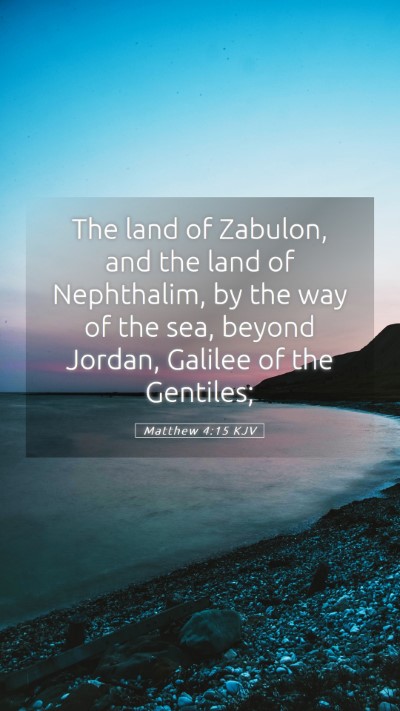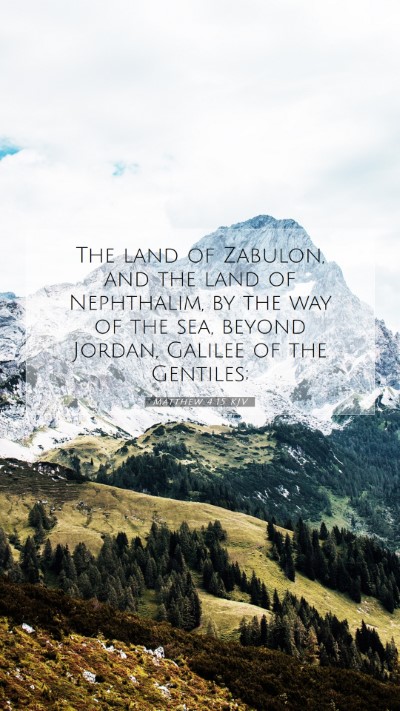Bible Verse Meaning: Matthew 4:15
Verse: "The land of Zebulun and the land of Naphtali, by the way of the sea, beyond the Jordan, Galilee of the Gentiles." (Matthew 4:15)
This verse serves as an introduction to the geographical context of Jesus's ministry, highlighting the significance of the regions of Zebulun and Naphtali. To grasp the meaning of Bible verses, we must examine both the historical and spiritual implications surrounding this scripture.
Contextual Understanding
The context of Matthew 4:15 is deeply rooted in Old Testament prophecy and Jewish history. Biblical exegesis reveals that these regions had been spoken of by the prophet Isaiah as places that would witness the light of Christ’s ministry. The areas were characterized by their cultural diversity, being near the Sea of Galilee, which was accessible to many Gentiles. Thus, this underscores the universal nature of Jesus's mission.
Insights from Public Domain Commentaries
-
Matthew Henry:
Henry emphasizes the fulfillment of prophecy that these regions would see a great light, signifying the arrival of the Messiah. He points out that despite their historical neglect and the shadow of former captivities, they were now blessed by Christ’s presence. This reflects on God’s grace, shining forth in unexpected places.
-
Albert Barnes:
Barnes provides a detailed geographical analysis, noting the strategic significance of these lands in Jesus’s teaching ministry. He explains that Galilee, being populated by both Jews and Gentiles, illustrates Jesus's role as the Savior for all humanity, thereby addressing the importance of understanding Scripture in its cultural context.
-
Adam Clarke:
Clarke focuses on the prophecies of Isaiah, which foretold the light that would shine in darkness. He highlights that this verse points to the spiritual awakening that Jesus would bring to those who walked in spiritual gloom. His commentary encourages readers to find Bible study insights through prophecy and its fulfillment, thus providing a richer, layered understanding of Matthew's Gospel.
Spiritual Implications
Beyond the geographical and historical analysis, the verse invites readers to reflect on the broader implications of Christ's mission. The regions of Zebulun and Naphtali not only represent a historical backdrop but symbolize the broader calling of the Gospel to reach marginalized and diverse communities. This aligns with the significance of Jesus' teachings, as He broke barriers to bring hope and light.
Application of Matthew 4:15
For modern believers engaging in Bible study, this verse is a call to examine how the message of Jesus extends beyond cultural and social boundaries. It challenges Bible study groups to consider whom they are reaching out to in the spirit of inclusivity and love. It encourages personal and communal reflection on how the light of Christ can penetrate today's cultural darkness.
Cross References
- Isaiah 9:1-2 - Prophecy of the great light
- Matthew 4:16 - Fulfillment of Isaiah's prophecy
- John 1:5 - The light shines in the darkness
- Luke 2:32 - A light to the Gentiles
- Acts 10:34-35 - God shows no favoritism
Conclusion
Matthew 4:15 stands as a pivotal verse in understanding the inception of Jesus's public ministry. It illuminates the connection between Old Testament prophecy and New Testament fulfillment, anchoring its interpretation in the assurance of God's unending grace and the inclusive nature of His eternal plan.
Engaging deeply with the Scriptures, as revealed through various bible study resources and commentaries, enhances our comprehension and appreciation for the word of God.


